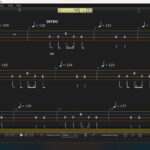My deep dive into the world of Fuzz Guitar Pedals began in 2018. While I already owned a few fuzzes, I embarked on a year-long quest to experience a wide spectrum of fuzz pedals, aiming for around 30 of the most acclaimed across various fuzz families. My initial goal was to complete this research within a year, allowing me to then explore other pedal categories.
However, my fuzz pedal journey quickly expanded beyond expectations. By the end of 2018, I had amassed twice the intended number, and this collection continued to grow in 2019, eventually exceeding 150 pedals. This diverse collection represents the major fuzz genres – Tone Benders, Fuzz Faces, and Big Muffs – alongside octave fuzzes, Rats (often considered fuzz-adjacent), oscillating fuzzes, modulated fuzzes, and a range of unique and specialized fuzz effects.
Through the process of acquiring and cataloging these fuzz guitar pedals, I developed a strong fascination with the various transistors used and their impact on tone. This article serves as a reference, born from my personal exploration of different fuzz transistors. It’s not an exhaustive catalog of every transistor type but rather a record of my encounters and preferences, a working document that I intend to update as my exploration continues. It’s important to note that some information might be nuanced due to the complexities within the transistor world, including practices like “gooping” (obscuring components), counterfeiting, repurposing, and inconsistencies in manufacturing and labeling.
The Intricacies of Transistor Branding and Quality Control in Fuzz Pedals
Historically, several manufacturers weren’t always consistent in their branding and quality control. The same transistor type could appear in different casings, under varying product codes, or sometimes with no markings at all. Many of these manufacturers also engaged in OEM production, creating products for different brands. This practice makes tracing the exact origin and history of certain transistor families a challenging, often nearly impossible task when examining fuzz guitar pedals.
Furthermore, the market includes numerous remakes of popular transistor types, particularly from Eastern European and Russian sources. Some of these are virtually indistinguishable from originals, while others are clearly counterfeit or mislabeled, designed to confuse builders and collectors of fuzz guitar pedals.
The Subtle Art of Transistor Selection for Fuzz Tone
Even within the same batch, transistors can exhibit significant performance variations due to manufacturing nuances and source material differences. Remarkably, transistors with identical hFE (current gain) measurements can still produce noticeably different sounds. This variability highlights the artisan aspect of “transistor wrangling.” The process of selecting the right transistors for fuzz guitar pedals often relies heavily on the builder’s ear and musical sensibility, rather than solely on technical specifications.
I won’t delve into excessive technical details here, as much of that is beyond my personal expertise. My primary interest lies in understanding what types of transistors are used in fuzz guitar pedals and the general reasons behind those choices.
A common question regarding transistors concerns the colored dots often seen on their casings. The answer, readily available online, is quite straightforward:
“A red dot or other color dot on the side of the transistor case only denotes the collector lead. A red spot elsewhere on older transistors – usually on the top – used to indicate the goodness/gain/frequency response of the device. Where the red spots – were considered the best, white spots – good, and unmarked signified low gain.”
[Imagine a photo of various transistors used in fuzz pedals, showcasing different types and casings here]
Alt text: A collection of various transistors, components crucial to the sound of fuzz guitar pedals, showcasing different casing types and markings, highlighting the diversity within fuzz pedal circuitry.
In the image above, you can see a selection of my preferred transistor types to date, presented in a variety of casing styles. These are some of the key components that contribute to the unique character of different fuzz guitar pedals. (Note: Transistors in the image are not shown to scale).
Conclusion: The Ongoing Exploration of Fuzz Transistors
The world of fuzz guitar pedals is deeply intertwined with the characteristics of the transistors at their core. Understanding these components, even at a basic level, provides valuable insight into the nuances of fuzz tone. My journey into fuzz is a continuous learning process, and the exploration of transistors remains a central and fascinating aspect of that adventure.

